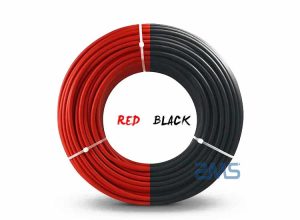Solar cables are the key to photovoltaic installations, large installations of solar farms, or small installations of homeowner solar systems. The characteristics of solar cables are determined by the special insulation and sheath material of the cable, which we call cross-linked polyethylene. Today, ZMS Cable will show you how to choose the right solar cable.

Features of The Solar Cable
The sheath of common cables has poor anti-ultraviolet performance, which leads to the aging of the outer sheath of the cable. The difference between solar cables and common cables is mainly in the materials of insulation and sheath.
The materials used in solar cables are irradiated materials, which are resistant to high temperatures, ultraviolet rays, and environmental protection.
After being irradiated by an irradiation accelerator, the molecular structure of the cable material will change, thereby providing its performance in all aspects.
In fact, during installation and maintenance, cables can be routed on sharp edges of roof structures, while cables are subject to pressure, bending, tension, cross-tensile loads, and strong shocks.
If the cable jacket is not strong enough, the cable insulation will be severely damaged, affecting the service life of the entire cable, or causing problems such as short circuits, fire, and personal injury hazards.
Prepare for The Solar Cable Project
While you are about to invest in solar cable, there are several things you need to consider.
One thing you need to consider is when you are wanting to use the solar cable. You must make certain the cable is certainly going to be strong enough to suit your needs, and that means that you need to understand the exact amount of weight that you simply plan to build using the solar cable.
You should also learn how far you intend to move the type of material. Not only that, but you are able to customize the type, so you have to know ahead of place where place the type should be.
Furthermore, you also need to examine such things as the maintenance requirements and precisely what the cable is created away from.
You might want to look into cables that are easy and portable to transport so that you don’t need too much trouble maintaining them.
Pricing is another significant consideration in regard to buying your cables.
You desire to make sure that the price of the cable suits your budget, and you also want to make certain you will not be paying an excessive amount for your solar cable. Taking the time to do the proper research will pay off big whenever you find the best price.
Basic principles of solar cable selection
The selection of cables for photovoltaic power generation follows the general requirements for cable selection.
That is, in accordance with the voltage level, to meet the continuous operation of the allowable current, short-circuit thermal stability, allowable voltage drop, economic current density, and laying environmental conditions factors such as selection.
At the same time, photovoltaic power generation has its own characteristics, solar energy systems are often used in harsh environmental conditions, such as high temperatures, cold and ultraviolet radiation.
(1) Insulation properties of solar flexible cables.
(2) The heat resistance and flame retardant properties of the cable.
(3) The cable’s moisture-proof, light-proof (anti-radiation).
(4) Cable laying mode.
(5) Cable conductor materials (copper core, aluminum alloy core); (6) Cable conductor materials (copper core, aluminum alloy core).
(6) Specification of cable cross-section.
You also need to consider whether to choose PV AC cables or PV DC cables.
PV DC cables
(1) The series connection cable between components and modules, this part should use a special cable with PV certification 9.
(2) Parallel cables between strings and between their strings to the DC distribution box (convergence box), which may optionally use rare earth aluminum alloy conductor cables.
(3) The PV wire between the DC distribution box to inverter, this part can also choose to use rare earth aluminum alloy conductor cable.
The above cables are all DC cables, which are laid more outdoors and need to be moisture-proof, sunproof, cold-resistant, heat-resistant, UV-resistant, and some special environments need to be protected against acid and alkali, and other chemical substances.
The connecting cables between components are usually supplied in sets with the components.
PV AC cables
(1) Connection cable from inverter to step-up transformer.
(2) Connection cable from the step-up transformer to the distribution unit.
(3) Connection cable from the distribution unit to the grid or the user.
The focus here is on the selection and laying of DC cables for grid-connected PV power generation Q. The principles are also applicable to some other types of photovoltaic power generation projects. PV power generation projects.
Vericable is a professional photovoltaic cable manufacturer, if you need PV installations that require high-quality cables, hope this was helpful. You can find more information on our websites.